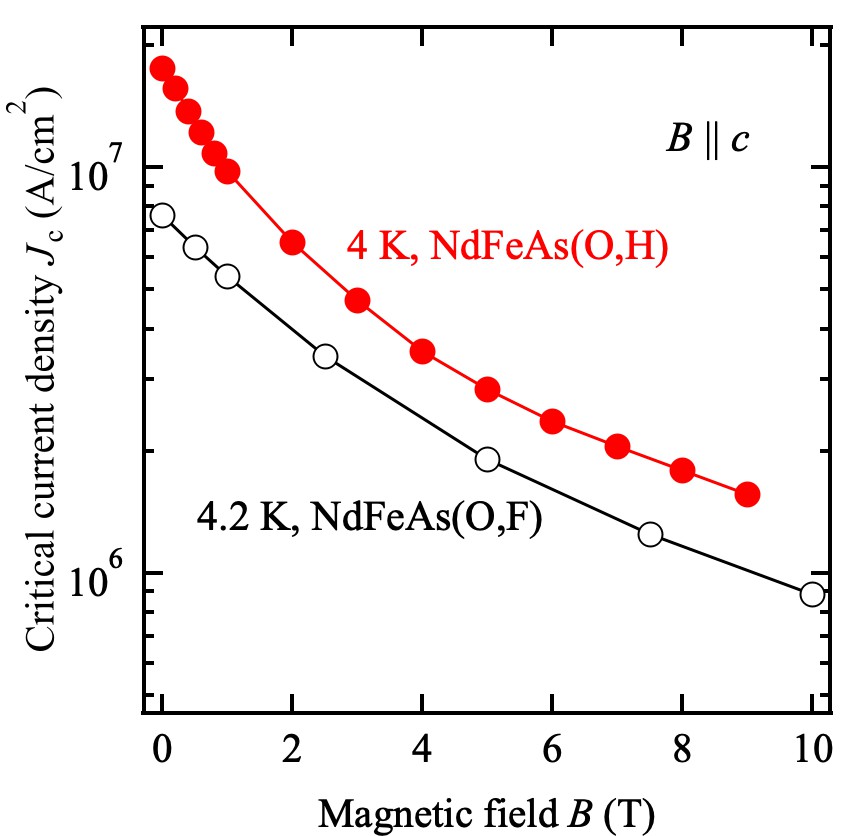PC9-8
Effect of Hydrogen Doping on the Superconducting Properties of NdFeAsO
Dec.3 18:00-18:15 (Tokyo Time)
Department of Materials Physics, Nagoya University1
The Ultramicroscopy Research Center, Kyushu University2
Department of Advanced Materials Science and Engineering, Kyushu University3
Institute of Technical Physics, Karlsruhe Institute of Technology4
JST CREST5
Partial substitution of hydrogen or fluorine for oxygen in LnFeAsO (Ln: Nd and Sm) leads to the highest superconducting transition temperature Tc ~55 K among the iron pnictide superconductors. The difference between H- and F-doping is the substitution limit: the former can be increased up to 80%[1], whereas the latter is around 20%[2]. Although the superconducting properties of heavily electron doped LnFeAsO polycrystals have been investigated, few studies of the critical current characteristics using single crystals have been reported.
Here, we have successfully fabricated H-doped NdFeAsO epitaxial thin films, which is the ideal form for investigating the transport properties, especially for the critical current characteristics[3]. H-doping was conducted by referring to [4]. Compared with single crystal growth, this method is rather simple once the parent LnFeAsO films are fabricated. The Hall measurements revealed that the carrier density n at 50 K estimated by a one-carrier-model for a NdFeAs(O,H) film with Tc around 46 K was around 5×1021 cm-3. The corresponding value for NdFeAs(O,F) having a similar Tcwas around 2×1021 cm-3, indicating that the carrier density n of NdFeAs(O,H) is larger than that of NdFeAs(O,F). The upper critical field for B || c of NdFeAs(O,H) was almost comparable to that of NdFeAs(O,F), but NdFeAs(O,H) showed a wider irreversible region. Additionally, the self-field critical current density Jc was in excess of 17 MA/cm2 at 4 K, which is roughly twice as large as NdFeAs(O,F) (Fig. 1). The details of the fabrication, structural as well as superconducting properties of our NdFeAs(O,H) thin films will be presented in the talk.
This work was supported by JST CREST Grant Number JPMJCR18J4 as well as JSPS Grant-in-Aid for Scientific Research (B) Grant Number 20H02681. A part of work was also partly supported by Advanced Characterization Platform of the Nanotechnology Platform Japan sponsored by the Ministry of Education, Culture, Sports, Science and Technology (MEXT), Japan.
[1] T. Hanna et al., Phys. Rev. B 84, 024521 (2011).
[2] M. Fujioka et al., Supercond. Sci. Technol. 26, 085023 (2013).
[3] K. Kondo et al., Supercond. Sci. Technol. 33, 09LT01 (2020).
[4] J. Matsumoto et al., Phys. Rev. Mater. 3, 103401 (2019).
Figure 1 Jc-B properties of the NdFeAs(O,H) and NdFeAs(O,F) films.
Keywords: hydrogen doping, iron-pnictides, thin films
